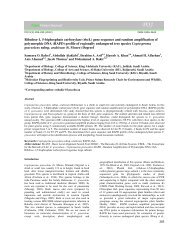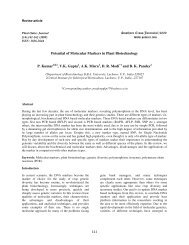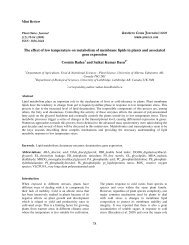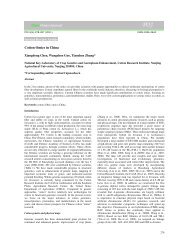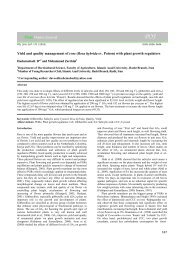You also want an ePaper? Increase the reach of your titles
YUMPU automatically turns print PDFs into web optimized ePapers that Google loves.
Results and discussionWe observed a high success rate of rbcL universal primersthan matK primers for PCR amplification of 26 plant speciesrepresenting a wide coverage of 14 families. Out of 26specimens, 23 (88%) were successfully amplified using rbcL-A and rbcL-B primer-pairs; both these pairs were equallyeffective in amplification success however the former pairresulted more intense bands. In contrast, only 7 (27%) and 18(69%) samples could be amplified by matK-A and matK-Bprimer-pairs respectively (Fig. 1). These findings corroboratewith the previous report on evaluation of the seven maincandidate plastid regions (rbcL, matK, rpoC1, rpoB, trnHpsbA,atpF-atpH, and psbK-psbI) in three divergent groups ofland plants (angiosperm, gymnosperm, and liverwort)demonstrated that no single locus has high levels ofuniversality and resolvability (Hollingsworth et al., 2009).The successful isolation of quality DNA plays an importantrole in molecular characterization using PCR-based methods.Numerous problems have been reported about the isolation ofplant DNA. Isolated plant DNA may contain coloredsubstances, polysaccharides and phenolic compounds (Araset al., 1993; Temiesak et al., 1993; Vanijajiva et al., 2005).The presence of certain metabolites may interfere with theplant DNA isolation procedures and downstream reactionssuch as PCR amplification. The chemotypic heterogeneityamong species may not permit optimal DNA yields with asingle protocol, and thus, even closely related species mayrequire different DNA isolation protocols (Khanuja et al.,1999). PCR conditions constitute one of the crucial factorsfor obtaining amplified products, especially for plants (Joneset al., 1997). In terms of absolute discriminatory power,promising results occurred in liverworts using rbcL alone(90% species discrimination) (Hollingsworth et al., 2009).Two plant species Malva parviflora (Malvaceae) and Saldolaimbricate (Chenopodiaceae) resulted in smaller amplifiedPCR product than the expected size with primers matK-A,indicating a different primer binding site for these species(Fig. 1). Three plant species belonging to the familyAsteraceae (Anthemis deserti, Pulicaria undulate, andSonchus oleraceus) were not amplified using the universalmatK and rbcL primers. The family Asteraceae (Compositae)is the largest family of the flowering plants and it seems to beanomalous as combined analyses of 10 chloroplast DNA locishowed 12 major lineages of this family (Panero and Funk,2008). The central concept in species identification is tomatch the sequence of the evidence item to a referencesequence, either through DNA sequence similarity searches(Altschul et al., 1997) or by phylogenetic reconstruction(Baker, 1994). Except RFLP, all the molecular markersincluding the barcoding genes require PCR-based protocols(Kumar et al., 2009). The use of universal primers isimportant for retrospective species identification as theyallow amplification across a wide taxonomic range governedby the PCR success rates, particularly for new or rarelystudied plant species of arid region. PCR amplification ofmatK and rbcL gene segments is a prerequisite forsubsequent sequencing of plant barcodes towards speciesidentification. Primer bias and non-universality have beenreported for dramatically skewing results (Soininen et al.,2009). Several studies have investigated the effects ofprimer-template mismatches and it has been demonstratedthat PCR can be prevented by a single mismatched base (Bruet al., 2008). Variation in primer specificity also affectssequence recovery at low DNA concentrations (Dawnay etal., 2007). Although we observed appreciable success inamplification of rbcL and matK genes, failure in PCRTable 1. List of plant specimens used in this study.FamilySpeciesApocynaceaeRhazya strictaAsteraceaeAchillea fragrantissimaAnthemis desertiPulicaria undulateScorzonera intricateSonchus oleraceusBrassicaceaeHorwoodia dicksoniaeMoricandia sinaicaZilla spinosaCaryophyllaceae Spergularia bocconiiChenopodiaceae Bassia eriophoraChenopodium muraleSalsola imbricateConvolvulaceae Convolvulus oxyphyllusEuphorbiaceaeAndrachene telephoidesGeraniaceaeErodium glaucophyllumE. laciniatumMalvaceaeMalva parvifloraPapilionaceaeAstragalus sieberiMelilotus indicaPoaceaePanicum antidotalePennisetum setaceumResedaceaeCaylusea hexagynaSolanaceaeLycium shawiiWithania somniferaZygophyllaceaeZygophyllum propinquumamplification in for certain species may be attributed toprimer mismatch at the annealing sites. The possibility ofpoor quality of extracted DNA in failed PCR is remotebecause we confirmed the quality of DNA on gel as well asspectrophotometrically. Moreover, in many cases, the sameDNA specimen showed negative amplification for matK butpositive PCR for rbcL, negating the role of poor DNA qualityor quantity in the former case. It is more likely that highfrequency of failure in PCR amplification of matK geneoccurred due to variations in the respective binding sites ofthese particular plant species of arid origin. The generation ofmatK sequences for ferns is currently problematic, becausethis part of the chloroplast genome underwent a strongrestructuring during the evolution of the fern clade (Duffy etal., 2009). Recently, rbcL and trnL-F were used (instead ofmatK) for the two locus barcoding of European ferns (de-Groot et al., 2011). Roy et al. (2010) have reported a poorsuccess in PCR for the species of Berberis. The maximumsuccess in PCR was observed with rbcL and ITS (97%),followed by trnH-psbA (92%) and matK (76%). The firstpractical problem for barcoding of plants is the acquirementof sufficiently clean DNA for multi-locus sequencing asisolated plant DNA contains PCR inhibitors (Aras et al.,1993; Temiesak et al., 1993; Vanijajiva et al., 2005). Thesecond technical issues of primer universality and sequencequality and complexity remain arguable for barcoding of allthe land plants of different region (Fox et al., 1992; Schneiderand Schuettpelz, 2006). Traditionally, the identification andcharacterization of cultivars and species has been based onmorphological and physiological traits which are sometimesdifficult (Kadkhodaei et al., 2010). Molecular tools that havebeen developed for the characterization for biodiversity mayallow classification of synonyms and detection of the originof species and cultivars (Rahman et al., 2009). Ongoingresearch on the development of universal primers, PCRconditions, and high throughput sequencing techniqueswould certainly enhance the application of DNA barcoding of196





